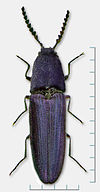Violet click beetle
| Violet click beetle | |
|---|---|

| |
| Scientific classification | |
| Kingdom: | |
| Phylum: | |
| Class: | |
| Order: | |
| Family: | |
| Genus: | |
| Species: | L. violaceus
|
| Binomial name | |
| Limoniscus violaceus (Müller, 1821)
| |
The violet click beetle (Limoniscus violaceus) is a black beetle, 12 mm long, with a faint blue/violet reflection. It gets its name from the family habit of springing upwards with an audible click if it falls on its back.
The beetle is listed in Annex II of the EC Habitats Directive and Schedule 5 of the UK's Wildlife and Countryside Act 1981. It is also listed as Endangered in the GB Red List. It is to be found in only a few locations in Europe, including three sites in Britain. These are Windsor Forest (where it was first found in 1937), Bredon Hill in Worcestershire (1989),[2] and Dixton Wood SSSI in Gloucestershire (1998).[3]
This sapro-xylophagous beetle is found only in the heart of decayed ancient trees, specifically in undisturbed wood-mould at the base of central cavities: in Britain it has been found only in beech and ash trees. Its very specific habitat requirements mean that the beetle is very rare, and even at the three sites where it has been found, there are few suitable trees, and their number is declining. One of the host trees at Windsor blew down in the Great Storm of 1987, but was re-erected solely as a host for the violet click beetle. English Nature's conservation efforts continue in an effort to create more suitable trees, including by erecting more decaying trees, and artificially aging some others.
The violet click beetle is one of the species that the Back from the Brink project aims to save from extinction.[4]
References
- ^ Méndez, M.; Dodelin, J.; Petrakis, P.; Schlaghamersky, J.; Nardi, G. (2010). "Limoniscus violaceus". The IUCN Red List of Threatened Species. 2010. IUCN: e.T157572A5098447. doi:10.2305/IUCN.UK.2010-1.RLTS.T157572A5098447.en. Retrieved 15 January 2018.
{{cite journal}}: Unknown parameter|last-author-amp=ignored (|name-list-style=suggested) (help) - ^ Natural England SSSI information on the citation for Bredon Hill SSSI
- ^ Natural England SSSI information on the citation for Dixton Wood SSSI which provides information on the three sites in Britain
- ^ "Back from the Brink". Back from the Brink. Retrieved 30 July 2018.
SSSI Source
- Natural England SSSI information on the citation for Dixton Wood SSSI
- Natural England SSSI information on the Dixton Wood unit
External links
- Natural England (SSSI information)

